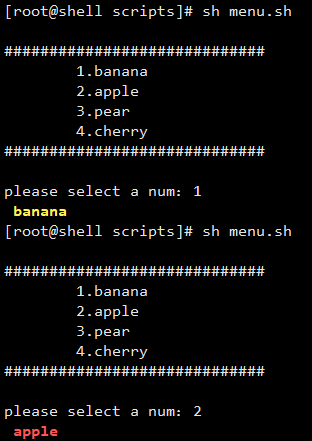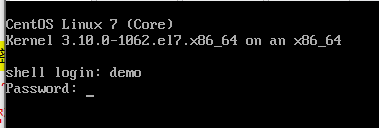您好,登錄后才能下訂單哦!
您好,登錄后才能下訂單哦!
這期內容當中小編將會給大家帶來有關如何在shell腳本中使用case條件語句,文章內容豐富且以專業的角度為大家分析和敘述,閱讀完這篇文章希望大家可以有所收獲。
#case條件語句的語法格式
case "變量" in 值1) 指令1... ;; 值2) 指令2... ;; *) 指令3... esac
#說明:當變量的值等于1時,那么就會相應的執行指令1的相關命令輸出,值等于2時就執行指令2的命令,以此類推,如果都不符合的話,則執行*后面的指令,要注意內容的縮進距離
#簡單記憶
case "找工作條件" in 給的錢多) 給你工作... ;; 給股份) 給你工作... ;; 有發展前景) 可以試試... ;; *) bye bye !! esac
#如果用戶輸入的是1-9的任意一個數字,則輸出對應輸入的數字,如果是別的字符,則提示輸出不正確并退出程序
[root@shell scripts]# cat num.sh #!/bin/bash #create by guoke #function number input read -p "please input a number:" num #打印信息提示用戶輸入,輸入信息賦值給num變量 case "$num" in 1) echo "The num you input is 1" ;; [2-5]) echo "The num you input is 2-5" ;; [6-9]) echo "The num you input is 6-9" ;; *) echo "please input number[1-9] int" exit; esac
#說明:使用read讀取用戶輸入的數據,然后使用case條件語句進行判斷,根據用戶輸入的值執行相關的操作
#執行效果
[root@shell scripts]# sh num.sh
please input a number:1
The num you input is 1
[root@shell scripts]# sh num.sh
please input a number:3
The num you input is 2-5
[root@shell scripts]# sh num.sh
please input a number:4
The num you input is 2-5
[root@shell scripts]# sh num.sh
please input a number:8
The num you input is 6-9
[root@shell scripts]# sh num.sh
please input a number:a
please input number[1-9] int
(1) banana
(2) apple
(3)orange
(4) cherry
#腳本編寫
[root@shell scripts]# cat menu.sh
#!/bin/bash
#create by guoke
#function print menu
RED_COLOR='\E[1;31m'
GREEN_COLOR='\E[1;32m'
YELLOW_COLOR='\E[1;33m'
BLUE_COLOR='\E[1;34m'
RES='\E[0m'
echo ' #使用echo打印菜單
#############################
1.banana
2.apple
3.pear
4.cherry
#############################
'
read -p "please select a num:" num
case "$num" in
1)
echo -e "${YELLOW_COLOR} banana ${RES}"
;;
2)
echo -e "${RED_COLOR} apple ${RES}"
;;
3)
echo -e "${GREEN_COLOR} pear ${RES}"
;;
4)
echo -e "${BLUE_COLOR} cherry ${RES}"
;;
*)
echo "please input {1|2|3|4}"
esac#說明:定義顏色,使用read讀取用戶輸入的數據,然后使用case條件語句進行判斷,根據用戶輸入的值執行相關的操作,給用戶輸入的水果添加顏色
#擴展:輸出菜單的另外種方式
cat<<-EOF =============================== 1.banana 2.apple 3.pear 4.cherry =============================== EOF
#執行效果
#如果輸入不正確或者不輸入的話就打印幫助
[root@shell scripts]# sh menu.sh
#############################
1.banana
2.apple
3.pear
4.cherry
#############################
please select a num:
please input {1|2|3|4}#輸入選項中的數字,打印相關信息

#主要思路:
#1.主要通過判斷nginx的pid文件有無存在,通過返回值查看有沒有運行
#2.通過case語句獲取參數進行判斷
#3.引入系統函數庫functions中的action函數
#4.對函數及命令運行的返回值進行處理
#5.設置開機自啟動
#附上nginx編譯安裝過程
#!/bin/bash yum install gcc pcre pcre-devel wget openssl openssl-devel.x86_64 -y mkdir -p /home/demo/tools cd /home/demo/tools/ wget -q http://nginx.org/download/nginx-1.6.3.tar.gz useradd nginx -s /sbin/nologin -M tar xf nginx-1.6.3.tar.gz cd nginx-1.6.3/ ./configure --user=nginx --group=nginx --prefix=/application/nginx --with-http_stub_status_module --with-http_ssl_module make make install ln -s /application/nginx-1.6.3 /application/nginx/ #做軟連接 /application/nginx/sbin/nginx -t #檢查語法 /application/nginx/sbin/nginx #啟動服務
#腳本編寫
[root@shell init.d]# chmod +x /etc/init.d/nginxd
[root@shell init.d]# cat nginxd
#!/bin/bash
#chkconfig: 2345 40 98 #設定2345級別,開機第40位啟動腳本,關機第98位關閉腳本
#create by guoke
#email:1075792988@qq.com
#function nginx start scripts
[ -f /etc/init.d/functions ] && source /etc/init.d/functions #引入系統函數庫
PIDFILE=/application/nginx/logs/nginx.pid #定義PID文件路徑
NGINX=/application/nginx/sbin/nginx #定義啟動命令路徑
value(){ #定義返回值函數
RETVAL=$?
if [ $RETVAL -eq 0 ];then
action "Nginx is $1" /bin/true
else
action "Nginx is $1" /bin/true
fi
}
start(){ #定義啟動函數
if [ -f $PIDFILE ];then #判斷PIDFILE存不存在,存在就打印運行,否則就啟動
echo "Nginx is running"
else
$NGINX
value start #調用返回值函數
fi
}
stop(){ #定義停止函數
if [ ! -f $PIDFILE ];then #也是通過判斷PID文件是否存在然后進行相關操作
echo "Nginx not running"
else
$NGINX -s stop
value stop
fi
}
reload(){ #定義重啟函數
if [ ! -f $PIDFILE ];then
echo "not open $PIDFILE no such directory"
else
$nginx -s reload
value reload
fi
}
case "$1" in #使用case接收腳本傳參的字符串
start) #如果第一個參數為start,調用start函數
start
;;
stop) #如果第一個參數為stop,調用stop函數
stop
;;
reload)
stop
sleep 1
start
;;
*)
echo "USAGE:$0 {stop|start|reload}"
exit 1
esac#執行效果
[root@shell init.d]# sh nginx stop
Nginx is stop [ OK ]
[root@shell init.d]# sh nginx start
Nginx is start [ OK ]
[root@shell init.d]# sh nginx reload
Nginx is stop [ OK ]
Nginx is start [ OK ]
#要求用戶登錄到跳板機后只能執行管理員給定的選項動作,不能中斷腳本而到跳板機服務器上執行任何系統命令
#思路
1.首先做好ssh key驗證登錄
2.實現遠程連接菜單選擇腳本
3.利用Linux信號防止用戶在跳板機上操作
4.用戶登錄后就調用腳本
#操作過程
3.1.做ssh免密鑰登錄,發送到各個主機,如果機器多的話可以使用腳本進行循環發送
[demo@shell ~]$ ssh-keygen -t dsa -P "" -f ~/.ssh/id_dsa Generating public/private dsa key pair. Enter file in which to save the key (/home/demo/.ssh/id_dsa): Created directory '/home/demo/.ssh'. Your identification has been saved in /home/demo/.ssh/id_dsa. Your public key has been saved in /home/demo/.ssh/id_dsa.pub. The key fingerprint is: SHA256:BTFfcC2hMKBzuZeUYylC3qgza7z4X6j3RBlwq8Beoak demo@shell The key's randomart image is: +---[DSA 1024]----+ | + o.*...+o | | . = B o O +. . | | = B B * + . | | o + = B + | |E = . + S | | . + o . | | + . o | | o o.o | |..+o... | +----[SHA256]-----+ #命令說明:一鍵生成密鑰,不用按回車。-t:指定要創建的密鑰類型,-P:提供舊密碼,空表示不需要密碼,-f:指定位置 #將公鑰拷貝到其他服務器的demo用戶 [demo@shell ~]$ ssh-copy-id -i .ssh/id_dsa.pub "demo@192.168.86.129" [demo@shell ~]$ ssh-copy-id -i .ssh/id_dsa.pub "demo@192.168.86.130" [demo@shell ~]$ ssh-copy-id -i .ssh/id_dsa.pub demo@192.168.86.131
#3.2.編寫腳本
[root@shell scripts]# cat tiaobanji.sh
#!/bin/bash
trapper(){ #定義屏蔽信號函數
trap '' INT QUIT TSTP TERM HUB
}
menu(){ #定義菜單列表函數
cat<<-EOF #加-后面的EOF就可以不用頂格
==============Host List==============
1) 192.168.86.129
2) 192.168.86.130
3) 192.168.86.131
4) 192.168.86.132
5) exit
=====================================
EOF
}
USER=demo
host(){ #定義主機列表函數
case "$1" in
1)
ssh $USER@192.168.86.129
;;
2)
ssh $USER@192.168.86.130
;;
3)
ssh $USER@192.168.86.131
;;
4)
ssh $USER@192.168.86.132
;;
5)
exit
esac
}
main(){ #定義主函數
while : #while循環,一直循環
do
trapper #調用trapper函數
clear #清屏
menu #調用菜單函數
read -p "please select a num:" num #獲取用戶輸入
host $num #調用主機列表函數和傳入的參數,進行遠程登錄
done
}
main #調用主函數#3.3.編寫腳本進行判斷,判斷是否是root用戶登錄,如果不是root用戶就執行腳本,彈出跳板機界面
[root@shell ~]# cd /etc/profile.d/ [root@shell profile.d]# cat jump.sh #!/bin/bash [ $UID -ne 0 ] && . /scripts/tiaobanji.sh
#3.4.測試
#登錄demo普通用戶輸入密碼的時候就會直接跳到選項卡頁面了

#選項卡頁面
==============Host List============== 1) 192.168.86.129 2) 192.168.86.130 3) 192.168.86.131 4) 192.168.86.132 5) exit ===================================== please select a num:1 #進行選擇 Last login: Tue Mar 31 23:48:33 2020 from 192.168.86.128 [demo@mysql ~]$
#3.5.提示:跳板機的安全
1.禁止跳板機可以從外網IP進行登錄,只能從內網IP登錄
2.其他服務器也限制只能內網IP登錄,同時禁止root登錄,做完ssh key認證,將密碼登錄禁止,通過免密碼登錄到其他服務器
#總結:if條件語句主要用于取值判斷、比較,應用比較廣,case條件語句主要是寫服務的啟動腳本,各有各的優勢。好了,shell腳本的條件語句就講解到這里了,接下來會繼續寫shell腳本的循環(包括for,while等),如果寫的不好的地方還望指出,多多交流提高,下次再會。。。
上述就是小編為大家分享的如何在shell腳本中使用case條件語句了,如果剛好有類似的疑惑,不妨參照上述分析進行理解。如果想知道更多相關知識,歡迎關注億速云行業資訊頻道。
免責聲明:本站發布的內容(圖片、視頻和文字)以原創、轉載和分享為主,文章觀點不代表本網站立場,如果涉及侵權請聯系站長郵箱:is@yisu.com進行舉報,并提供相關證據,一經查實,將立刻刪除涉嫌侵權內容。